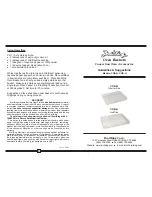
7
cont. equipment
www.lecavist.com
6.4 Defrosting
Your appliance is equipped with an automatic defrost
cycle. When a cooling cycle finishes, the appliance’s
refrigerated surfaces are defrosted automatically.
The defrost water is channeled into a condensates
evaporation tray which is located in the back of the
appliance near the compressor. The heat produced
by the compressor then evaporates the condensates
collected in the tray.
.
6.5 Shelves
Back of the shelf
Front of the shelf
>
To prevent damage to the door seal, ensure that the
door is fully open before pulling out the shelves to
add or remove bottles.
>
For easier access to the contents of the shelves, slide
the shelf out approximately one third of the way.
The shelves are, however, fitted with a stop to prevent
the bottles falling out.
8.1 In case of a power cut
> Most power cuts are resolved within a short time. A power cut of 1 or 2 hours will not affect the temperature in your cabinet.
To protect your wines during a power cut, avoid opening the door as much as possible.
> During very long power cuts, take the necessary measures to protect your wine. If the appliance is disconnected or if there
is a power cut, you must wait three to five minutes before restarting. If you try to re-start before this time, the compressor will only
re-start after 3 to 5 minutes (if the temperature requires). When switching on for the first time or following a prolonged shutdown,
it is possible that when re-starting, the temperatures selected and those displayed are not the same. This is normal. It will take a
few hours before they stabilize.
8.2 Moving your wine cooler
Remove all items.
>
Securely tape down all loose items (shelves) inside your appliance.
>
Turn the adjustable leg up to the base to avoid damage.
>
Tape the door shut.
>
Be sure the appliance stays secure in the upright position during
transportation. Also protect outside of appliance with a blanket,
or similar item.
> The maximum recommended loading quantities for
bottles are given as guidelines and are indicative only;
they provide a quick estimate of the size of the appliance
(similar to the capacity of a refrigerator expressed in liters).
> Before cleaning your appliance (something that should
be done regularly), disconnect it by removing the plug or
by pulling the fuse on the circuit.
> Before using your appliance for the first time and
regularly after that, we recommend that you clean the
inside and outside (front, side and top) with warm mixed
with a gentle cleaning product. Rinse with clean water and
allow drying before reconnecting. Do not use solvents or
abrasives. When the appliance is switched on for the first
time, there may be a residual odor. In that case, runt the
appliance empty for a few hours at the coldest possible
temperature. The cold will kill any odors.
> They correspond to tests conducted with a standard bottle:
the standard “75 cl light Bordeaux” bottle -standards apply
the geographical origin of each bottle shape (Bordeaux,
Burgundy, Provence, etc.) and a type (traditional, heavy,
light, flute, etc.), each with its own diameter and height.
> These caves present bottles of wine, thanks to the
highlighting of the labels of each wine. You will find below
the plan of loading of your bottles on a clay, knowing that
it is possible to put up to 9 bottles on a shelf.
Opinions vary, and the ambient temperature too,
but many people agree on the following:
Prestigious Bordeaux wines – Reds 16 – 17°C
Prestigious Burgundy wines – Reds 15 – 16°C
Prestigious dry white vintages 14 – 16°C
Light, young, fruity reds 11 – 12°C
Provence rosés, primeur wines 10 – 12°C
Dry whites and vin de pays reds 10 – 12°C
Vin de pays whites 8 – 10°C
Champagnes 7 – 8°C
Sweet wines 6°C
6.6 The winter function
The winter function is a frost protection system which
enables the cellar to operate in an environment where
the temperature is between 5 and 38°C. A sensor
located outside the appliance triggers a low power
electrical element when the ambient temperature in
the room falls to around 8°C in case. This is a low
power element to avoid sudden rises in the temperature
of the wine and so avoid thermal shocks that are
damaging to the preservation of the wine. The kit is
intended to raise the cellar’s internal temperature even
before there is a thermal exchange with the bottles.
7. LOADING
8. CARE AND MAINTENANCE




























